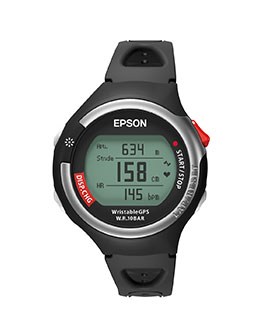The WristableGPS SS700S, Runsense Sports Monitor
Product Features
August 2012

Specifications
Thickness: 15.7 mm
Weight: 61 g
Water resistance: 10 bars
Battery life:
14 hours when GPS is on
5 weeks when displaying the time (GPS off)
Operating temperature: -5 to 50°C
Other features*:
Auto pause, auto lap, stride sensor, heart rate monitor*
Application software: NeoRun (displays route maps, speed & elevation graphs, heart rate, and calories burned)
* Heart rate measured using an accessory chest strap
The Runsense series marked Epson's first foray into the electronic sporting goods market. Launched first in Japan as the WristableGPS SS700S, Epson's initial product in the series was a wristwatch-like GPS sports monitor that accurately tracks and keeps records of a runner's or other athlete's distance, pace, and other performance parameters. The signature feature of this first model in the Runsense family (called WristableGPS in Japan) in some overseas markets) is its long battery life. Capable of continuous GPS tracking for up to 14 hours, it easily meets the needs of marathoners, with time to spare. As a provider of GPS modules for cell phones, Epson has a storehouse of technology and know-how that enabled it to develop the low-power, battery-life extending GPS module used in this sports monitor. Epson was also able to draw on its more than seven decades' worth of experience in the watch business to create a sports monitor that is thin, lightweight, comfortable, breathable, and easy to use. Excellent water resistance means that runners and triathletes can concentrate on their times instead of worry about their device and the weather. A built-in stride sensor automatically works out the user's stride based on his or her actual speed and the body's vibration frequency. The stride sensor enables the monitor to accurately calculate distance and pace even in locations where the monitor cannot receive GPS signals, such as in tunnels or when surrounded by tall buildings.
Story Behind the Creation
In 2012, the year the first Runsense product was released, the running population was rapidly multiplying, particularly in developed countries, and Japan was no exception. Japan was seeing the number of runners and the popularity of distance races surge. In fact, Japan's adult runner population, including both serious marathoners and recreational joggers looking to keep healthy, had continued to grow at an average annual rate of more than 10% since 2006, and the number of people who ran at least once a year topped an estimated 10 million1. The popularity of running spawned a market for GPS sports monitors. Runners wanted to be able to accurately measure their distance and speed, as well as improve their performance and exercise efficiency.
Looking to meet the disparate needs of a spectrum of runners, from weekend joggers to serious racers, Epson developed a comfortable GPS sports monitor with excellent water resistance and long battery life that helps runners maximize the benefits of running by accurately logging their running data for later verification.
1 Source: "Sporting Life Survey 2012," a nationwide survey conducted by Sasakawa Sports Foundation
Reception and Market Impact
Epson's Runsense sports monitor, which earned high praise from users, have continued to evolve to meet user needs. The biggest advances were made in further reducing the power consumption of the GPS module. In November 2013 Epson launched the SF series of Runsense sports monitors. The three models in this series feature a battery life of up to 30 hours while updating GPS position data every second. The long battery life enabled Epson to solidify a major competitive advantage over rival products. Users no longer had to worry about running out of battery life even during 100-km ultra-marathons, nor were they burdened with the need for frequent recharging. Epson also developed a unique antenna for the GPS module. This antenna allows users to capture accurate distance and altitude data even in urban canyons and mountainous areas where radio interference is high and signal reception poor. Epson has continued to evolve its Runsense sports monitors ever since they were first launched to market in 2012, adding new features, designs, and color variations. The performance of these monitors, which has won high praise from athletes, has enabled Epson to maintain the No. 1 share of the Japanese sports monitor market2 for three consecutive years.
2 Source: "Future Outlook of the Digital Health Solutions Market" published by Fuji Chimera Research Institute, Inc. in 2012, 2013, and 2014


